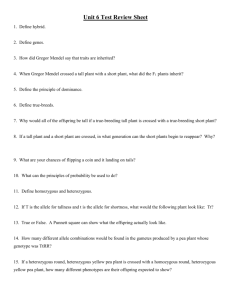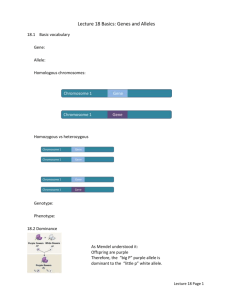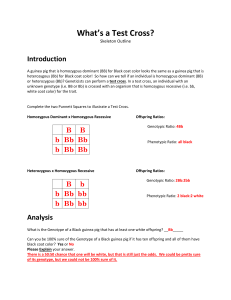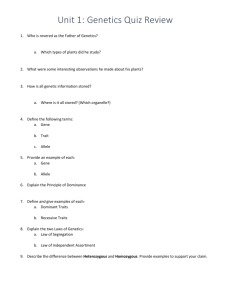Monohybrid sheet
advertisement
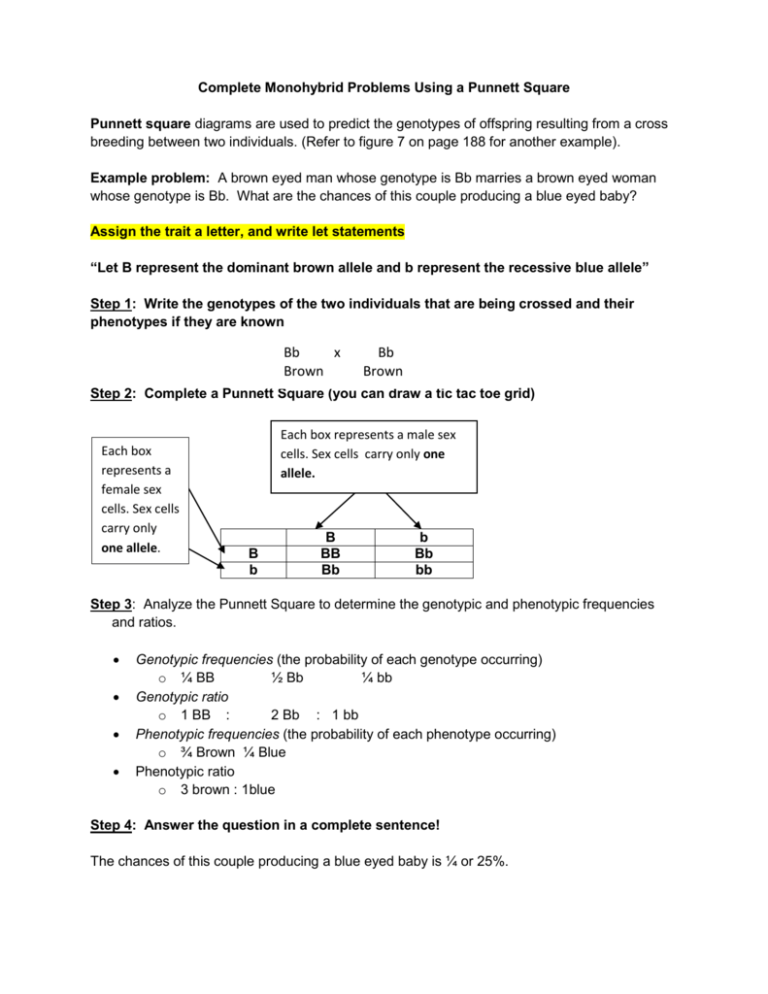
Complete Monohybrid Problems Using a Punnett Square Punnett square diagrams are used to predict the genotypes of offspring resulting from a cross breeding between two individuals. (Refer to figure 7 on page 188 for another example). Example problem: A brown eyed man whose genotype is Bb marries a brown eyed woman whose genotype is Bb. What are the chances of this couple producing a blue eyed baby? Assign the trait a letter, and write let statements “Let B represent the dominant brown allele and b represent the recessive blue allele” Step 1: Write the genotypes of the two individuals that are being crossed and their phenotypes if they are known Bb x Brown Bb Brown Step 2: Complete a Punnett Square (you can draw a tic tac toe grid) Each box represents a female sex cells. Sex cells carry only one allele. Each box represents a male sex cells. Sex cells carry only one allele. B b B BB Bb b Bb bb Step 3: Analyze the Punnett Square to determine the genotypic and phenotypic frequencies and ratios. Genotypic frequencies (the probability of each genotype occurring) o ¼ BB ½ Bb ¼ bb Genotypic ratio o 1 BB : 2 Bb : 1 bb Phenotypic frequencies (the probability of each phenotype occurring) o ¾ Brown ¼ Blue Phenotypic ratio o 3 brown : 1blue Step 4: Answer the question in a complete sentence! The chances of this couple producing a blue eyed baby is ¼ or 25%. Practice with Monohybrid Crosses 1. Set up the Punnett square for each of the crosses listed below. Round seeds are dominant to wrinkled seeds. Rr x rr What percentage of the offspring will be round? ___________ Rr x Rr What percentage of the offspring will be round? ___________ RR x Rr What percentage of the offspring will be round? ___________ Practice with Crosses. 2. A TT (tall) plant is crossed with a tt (short plant). What percentage of the offspring will be tall? ___________ 3. A Tt plant is crossed with a Tt plant. What percentage of the offspring will be short? ______ 4. A heterozygous round seeded plant (Rr) is crossed with a homozygous round seeded plant (RR). What percentage of the offspring will be homozygous (RR)? ____________ 5. A homozygous round seeded plant is crossed with a homozygous wrinkled seeded plant. What are the genotypes of the parents? __________ x __________ What percentage of the offspring will also be homozygous? ______________ 6. In pea plants purple flowers are dominant to white flowers. If two white flowered plants are cross, what percentage of their offspring will be white flowered? ______________ 7. A white flowered plant is crossed with a plant that is heterozygous for the trait. What is the phenotypic ratio of the offspring plants? _____________ 8. Two plants, both heterozygous for the gene that controls flower color are crossed. What is the genotypic ratio of the offspring plants? ______________ What is the phenotypic ratio of the offspring plants? ___________ 9. In guinea pigs, the allele for short hair is dominant. What genotype would a heterozygous short haired guinea pig have? _______ What genotype would a purebreeding short haired guinea pig have? _______ What genotype would a long haired guinea pig have? ________ 10. Show the cross for a pure breeding short haired guinea pig and a long haired guinea pig. What percentage of the offspring will have short hair? __________ 11. Show the cross for two heterozygous guinea pigs. What percentage of the offspring will have short hair? ________ What percentage of the offspring will have long hair? _______ More Genetics Problems: Monohybrid Crosses 1. You are given the genetic cross of pea plants: TT x tt. a) What is the genotype of each of the parents? b) What is the phenotype of each of the parents? c) What are the possible gametes that can be produced by each parent? d) Show the genotypes of the F1 generation. What are the phenotypes of the F1 generation? 2. If G represents the dominant green trait, and the recessive allele produces a yellow trait, show the genotypes of the F1 generation of the P1 cross GG x gg. Give the phenotypes of the parents and the offspring. 3. Show the genotypes and phenotypes of the F1 generation if a heterozygous green pea plant is crossed with a homozygous yellow plant (given the information in #2). 4. Show the phenotypic and genotypic ratios of the F1 generation if a heterozygous tall pea plant is crossed with a dwarf pea plant. (Note: tall is dominant) 5. Mendel found that the allele for inflated pods in peas (I) is dominant to its allele for narrowed pods (i). What offspring phenotypes would be expected from the following crosses and in what ratio? a) heterozygous self-fertilized b) homozygous inflated x heterozygote c) heterozygote x homozygous narrowed 6. A number of plant species have a recessive allele for albinism; homozygous albino (white) individuals are unable to synthesize chlorophyll. If a tobacco plant that is heterozygous for albinism is allowed to self-pollinate and 500 of its seeds germinate: a) how many of these offspring will be expected to have the same genotype as the parent plant? b) how many seedlings will be expected to be white? 7. Sniffles, a male mouse with a coloured coat, was mated with Esmeralda, an alluring albino. The resulting litter of six young mice all had coloured fur. The next time around, Esmeralda was mated with Whiskers, who was the same colour as Sniffles. Some of Esmeralda’s second litter were white (albino). a) What are the probable genotypes of Sniffles, Whiskers, and Esmeralda? b) If a male of the first litter were mated with a coloured female of the second litter, what phenotypic ratio might be expected among the offspring? c) What would the expected results be if a male from the first litter were mated with an albino female from the second litter? 8. What are the most likely genotypes of the parents if a cross of two pea plants produces 60 round seeds and 20 wrinkled seeds? (Note: round is dominant)

